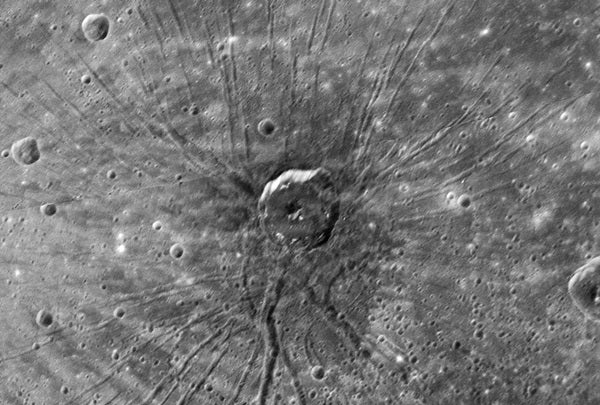Dr. Sean Solomon, MESSENGER’s Principal Investigator, presented a model that suggests the origin of the Pantheon Fossae, a radiating web of troughs located in the giant Caloris Basin, is directly linked to an impact crater at the centre of the web.
The Caloris Basin is the youngest-known large impact basin on Mercury. The basin was discovered in 1974 during Mariner 10’s flyby, but the centre of the basin had not been seen until MESSENGER’s first flyby January 14.
MESSENGER revealed that the crater’s interior appeared to have been flooded by volcanic material in a similar way to the lunar mare basins. A ring of troughs was observed around the circumference of the basin. However, the biggest surprise was the discovery of radiating pattern of troughs, initially dubbed “the spider” by the team, which was unlike any structure seen in lunar basins or elsewhere on Mercury.
The troughs are hundreds of miles in length and the central crater, named Apollodorus after the architect of the Pantheon temple in Rome, is about 25 miles (40 km) across. Several models have been proposed for their formation, including uplift of the basin due to heating from below, pressure building up from the superposition of surrounding plains or inward crustal flow. However, to date, none of these models could explain the radial pattern observed.
Dr. Solomon and colleagues developed a three-dimensional model of deformations in Mercury’s crust in the Caloris Basin and then modeled the effect of an asteroid impact at the centre.
“We found that stresses building up within the crust could explain the troughs found around the circumference of the basin but not the radial web at the centre. When we modeled the effect of a meteorite striking the centre of a pre-stressed basin floor, we found that the formation of the crater relieved the stress build-up and weakened the central area, allowing the troughs to spread out like cracks in a windscreen,” said Dr. Solomon.
As the crater appears to be superimposed over the troughs, it appears that the Pantheon network formed simultaneously with the Apollodorus crater.
However, not all scientists agree that the crater’s presence at the centre of the web is anything more than coincidence.
Professor Jim Head, of Brown University in Providence, Rhode Island, and co-investigator of the MESSENGER mission believes that volcanic activity could have caused the Pantheon troughs. An upflow of magma at the centre of the basin could have formed a reservoir at depth and a radial network of dykes.
“The first MESSENGER flyby provided a lot of evidence that volcanism has played an important role in Mercury’s history, in particular around the Caloris Basin. We found what appears to be a shield volcano located just outside the Caloris Basin, and the area is surrounded by smooth plains, relatively free from impacts, which suggests a young surface. Given the amount of volcanic activity we’re discovering in that area, I wouldn’t want to rule out a volcanic cause just yet. Maybe MESSENGER’s second flyby will help us solve the mystery,” said Prof. Head.










